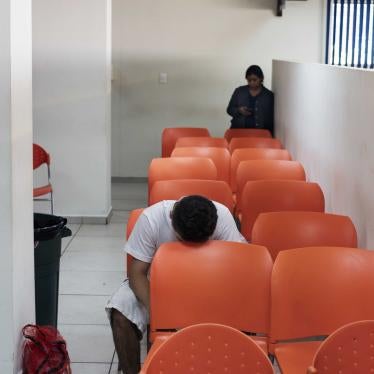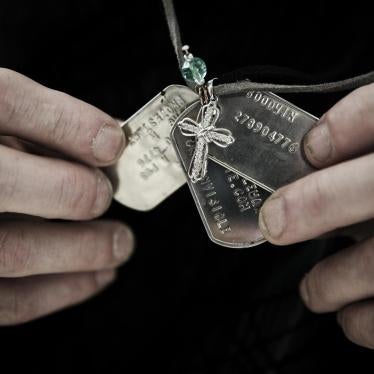Human Rights Watch submits these comments to the Department of Homeland Security (DHS) in response to its Notice of Proposed Rulemaking regarding Standards To Prevent, Detect, and Respond to Sexual Abuse and Assault in Confinement Facilities. Our comments address only the standards that apply to immigration detention facilities, and not those designed solely for holding facilities.
We commend the Department of Homeland Security for proposing comprehensive standards that, if fully implemented, should greatly reduce sexual abuse in facilities that confine immigration detainees. While we have concerns about some of the standards, we think as a whole they reflect a commitment to protect detainees from sexual abuse and to ensure that perpetrators are held accountable. The standards will apply to all immigration detainees, regardless of whether they are held in federal, state, local, or privately owned facilities, providing much needed uniformity in the protection against sexual abuse afforded to these uniquely vulnerable men, women, and children.
Ultimately, however, the protection of immigration detainees from sexual abuse will depend as much on the commitment of DHS to ensure immigration facilities fully incorporate the letter and spirit of PREA into their work as on the specific text of the final standards. We urge DHS to allocate sufficient staff and give them the authority and time to continually monitor the sexual abuse prevention and response policies and practices of the facilities in which immigration detainees are confined to ensure they reflect DHS’s zero-tolerance goal. We also urge DHS to adopt a standard that would prevent Immigration and Customs Enforcement (ICE) or any other component of DHS from sending detainees to facilities that do not fully comply with the standards.
Because we believe prison rape is an inexcusable and unacceptable violation of human rights, Human Rights Watch has worked for years to draw the public’s attention to its prevalence in the nation’s confinement facilities—including those that confine immigration detainees—and to advocate for changes in policies and practices that would eliminate such abuse.[1] We strongly supported the National Prison Rape Elimination Act (PREA) unanimously passed by Congress in 2003 and were honored to have a staff member serve as a commissioner on the National Prison Rape Elimination Commission (the Commission) created by PREA.[2]
PREA instructed the Commission to prepare an analysis of the causes and consequences of prison rape and to propose national standards to the attorney general, which it did in June 2009. The Department of Justice (DOJ) standards released on May 17, 2012 drew heavily on the Commission’s work and reflect the goal of establishing an effective, zero-tolerance policy toward sexual abuse in confinement facilities. Human Rights Watch hailed the standards as offering landmark protection against sexual abuse and characterized the standards as a practical, feasible roadmap for officials on how to end the epidemic of prison rape.[3] The DOJ standards do not apply to DHS, but inaMay 17, 2012 White House memorandum to the heads of executive departments and agencies, President Obama directed all agencies with federal confinement facilities (including DHS) “that are not already subject to the Department of Justice’s final [PREA] rule to work with the Attorney General to propose, within 120 days of the date of this memorandum, any rules or procedures necessary to satisfy the requirements of PREA and to finalize any such rules or procedures within 240 days of their proposal.” The standards proposed in this rule-making proceeding reflect the work DHS has done pursuant to the president’s memorandum.
Immigration detention is the fastest-growing incarceration system in the US. In 2010, ICE had custody of over 400,000 people in about 250 detention facilities. Some were held in service processing centers operated directly by ICE and others in contract detention facilities managed by private companies, state and county jails under contract with ICE, or facilities run by the Federal Bureau of Prisons. Juvenile immigrant detainees are held in facilities operated by the US Department of Health and Human Services. While the average immigration detainee is detained 30 days, for some, detention can last years.
Immigration detainees deserve effective protection against sexual abuse, no less than any other person in confinement. Language and cultural barriers, histories of state-sanctioned abuse in their home countries, and a fear that reporting abuse will result in deportation all increase the likelihood that a non-citizen will not feel safe reporting sexual abuse and that perpetrators will not be held accountable. Unlike criminal defendants, immigration detainees have no right to an attorney, and as a result may not be aware of their right to be free from sexual abuse, nor whom to contact if they are sexually assaulted.
The known incidents and allegations of sexual abuse in immigration detention are serious and numerous. In its 2009 report to the attorney general, the National Prison Rape Elimination Commission documented widespread reports of sexual abuse in immigration facilities over the last 20 years.[4] In August 2010, Human Rights Watch released a report compiling incidents and allegations of assaults, abuses, and episodes of harassment that have emerged across the rapidly expanding national immigration detention system.[5] These included the assaults of five women detained at the Port Isabel Service Processing Center in Texas in 2008, when a guard entered each of their rooms in the infirmary, told them that he was operating under physician instructions, ordered them to undress, and touchedintimate parts of their bodies.[6] In 2009, the Women’s Refugee Commission released a report that documented incidents of sexual and physical abuse of unaccompanied children in immigration custody, including the repeated sexual assaults of children at the Away From Home Texas Sheltered Care Facility in Nixon, Texas.[7]
We commend DHS for proposing standards that for the most part are as strong as, and in some cases even stronger than, those adopted by DOJ. Indeed, the proposed DHS standards reflect the extensive prior work by the Commission and DOJ. In addition, by adopting the DOJ template with regard to the categorization of standards, DHS will enable more consistent treatment of immigration detainees who are often transferred between facilities; vastly different standards depending on the nature of the facility (for example, a local jail or privately operated detention center) would undercut the goal of PREA, as detainees cannot be expected to be aware of shifting rights depending on which facility they are in.
Nevertheless, there are a few important areas where DHS has proposed standards that will not protect detainees as effectively as DOJ standards and for which the weaker standards are not justified. In the interests of brevity, in the comments below we focus solely on aspects of the standards that we believe need to be revised to ensure that DHS adopts strong, feasible, and cost-effective standards to prevent, detect, and respond to all forms of sexual abuse of immigration detainees.
[See attached document for complete comments.]
[1] Human Rights Watch, All too Familiar: Sexual Abuse of Women in U.S. State Prisons (New York: Human Rights Watch, 1996); Human Rights Watch, No Escape: Male Rape in US Prisons (New York: Human Rights Watch, 2001), https://www.hrw.org/legacy/reports/2001/prison/; Human Rights Watch, Detained and at Risk: Sexual Abuse and Harassment in United States Immigration Detention, August 25, 2010, https://www.hrw.org/en/reports/2010/08/25/detained-and-risk-0.
[2] Jamie Fellner, senior advisor to the US Program of Human Rights Watch, served as a commissioner with the National Prison Rape Elimination Commission. She is the principal author of these comments.
[3] “US: New Prison Rape Standards Offer Landmark Protection,” Human Rights Watch news release, May 17, 2012, https://www.hrw.org/news/2012/05/17/us-new-prison-rape-standards-offer-la....
[4] National Prison Rape Elimination Commission, “Standards for the Prevention, Detection, Response, and Monitoring of Sexual Abuse in Adult Prisons and Jails: Supplemental Standards for Facilities with Immigration Detainees,” June 2009, http://www.ncjrs.gov/pdffiles1/226680.pdf (accessed January 15, 2013), pp. 174-188.
[5] Human Rights Watch, Detained and at Risk, August 25, 2010.
[6] Ibid., p. 8.
[7] Women's Refugee Commission, Halfway Home: Unaccompanied Children in Immigration Custody, February 2009, http://womensrefugeecommission.org/programs/detention/unaccompanied-chil... (accessed January 15, 2013).





